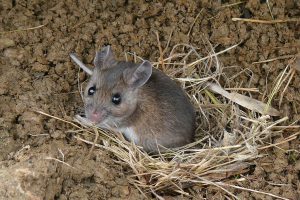
Tiny mammals pack a huge ecological punch
Rebecca Rose, Conservation Liaison for Ohio Wildlife Center, explores a key omnivore and its role in healthy forests
Of all the mammals on the planet, rodents are undoubtedly the most significant single group. With more than 2,277 species, they make up an astounding 35 percent of the Earth’s living mammals (bats are second with 1,390 species). Found throughout the world, except Antarctica, New Zealand and some remote islands, rodents live diverse lifestyles from the subterranean naked mole rats, to flying squirrels, to the industrious dam-building beavers to the semi-aquatic capybaras of South America. Capybaras can weigh more than 150 pounds. The adaptability of rodents for life on Earth is rivaled only by the adaptability of humans.
The Ohio Division of Wildlife lists 20 rodent species found in the state, including some with the status of endangered, threatened or species of concern. In 2018, Ohio Wildlife Center’s Wildlife Hospital admitted 814 rodents from 12 species, including the diminutive and ecologically important white-footed mouse.
White-footed mice are adaptable and live in a variety of habitats, building their nests in warm, dry places like hollow trees and empty bird nests. These little mammals must be secretive and alert as they are the major food supply for many small predators, including weasels, snakes, owls, falcons and red foxes. Their cryptic coloration, which enables them to hide in plain sight, plus excellent hearing, eyesight, and sense of smell, give them some protection from their numerous predators. Since they are nocturnal, they use their whiskers as touch receptors and are also good climbers and swimmers.
The lives of these little mammals are on a fast-track from the beginning. Baby white-footed mice (called pups) are born blind, hairless, and helpless after only a 22-day gestation period. Their eyes open 12 days later, and the mothers nurse the pups in the nest until they are weaned (at about three weeks). Shortly after that, they leave their mothers and the female pups become sexually mature at only two and a half months old. The females can have two to four litters each year, with between two and nine pups in each litter. For most white-footed mice, their life span runs about one year.
Scientists cannot yet explain why, but white-footed mice have a distinctive behavior of drumming on a hollow reed or a dry leaf with their front paws. According to Ohio Wildlife Center’s hospital staff members, the little mice have this behavior even while being cared for at the hospital.
As omnivores, white-footed mice feed on a variety of seeds, berries, nuts, grains, fruits, insects, and fungi. This diet is a clue to the important ecological roles these mice play – both as seed dispersers and spreaders of fungi. By eating the fruits of fungi and excreting spores, mice contribute to healthy forests. For many trees, these fungi have been shown to be an essential element for them to prosper. The trees form a symbiotic relationship with the fungi that enhances their ability to absorb water and other important nutrients from the soil. It’s complicated, but all the pieces of the puzzle matter to have healthy ecosystems. To learn more about the secret partnerships between plants and fungi, information is available here.
It’s difficult to see, let alone photograph, such a small animal in the wild. We thank Jim McCormac for the use of his photo of a white-footed mouse in the wild.
***Note: The mouse most closely associated with living inside human dwellings is the house mouse. Ohio Wildlife Center’s SCRAM! technicians have some tips for humanely excluding mice from homes or other buildings: 1. Check the exterior of your house for cracks or openings and plug them with steel wool – mice can chew through other materials. 2. Store items that could potentially be made into nesting materials (newspapers, cardboard, tissue) in a plastic tote. 3. Keep birdseed, dog food and any other food items in a sealed container.